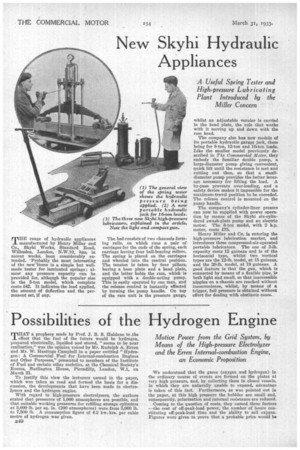Possibilities of the Hydrogen Engine
Page 54

Page 55

If you've noticed an error in this article please click here to report it so we can fix it.
Motive Power from the Grid System, by Means of the High-pressure Electrolyzer and the Erren Internal-combustion Engine, an Economic Proposition
THAT a prophecy made by Prof. J. B. S. Haldane to .the effect that the fuel of the future would be hydrogen, prepared electrically, liquified and stored, "seems to be near realization," was the opinion voiced by Mr. Rudolph A. Yuen and Mr. W. Hastings Campbell in a paper entitled "Hydrogen : A Commercial Fuel for Internal-combustion Engines and Other Purposes," presented to members of the Institute of Fuel and certain other societies, at the Chemical Society's Rooms, Burlington House, Piccadilly, London, W.1, on Yarch 21.
To justify this view the lecturers named in the paper, which was taken as read and formed the basis for a discussion, the developments that have been made in electralyzers and the hydrogen engine.
With regard to high-pressure electrolyzers, the authors stated that pressures of 1,000 atmospheres are possible, and that suitable working pressures for refilling storage cylinders at 3,000 lb. per sq. in. (200 atmospheres) were from 5,000 lb. to 7,500 lb. A consumption figure of 4.2 kw.-hrs. per cubic metre of hydrogen was given.
We understand that the gases (oxygen and hydrogen) in the ordinary course of events are formed on the plates at very high pressure, and, by collecting them in closed vessels, in which they are naturally unable to expand, advantage is taken of this fact. Furthermore, as was pointed out in the paper, at this high pressure the bubbles are small and, consequently, polarization and internal resistance are reduced.
Coming to the question of costs, they named three factors —the cost of off-peak-load power, the number of hours constituting off-peak-load time and the ability to sell oxygen. Figures were given to prove that a probable price would be
1.17d, per cubic metre, disregarding the value of the by
product.
An incidental point mentioned was the deviation, in the behaviour of hydrogen, from Boyles law of compressed gases. One cubic metre at 200 atmospheres, it appears, yields only 176 cubic metres on release. Another peculiarity of the gas is its temperature rise on expansion. Liquid hydrogen was said to be the lightest fuel known, but bulky ; there is, however, no difficulty about storing it. Weight for weight, the calorific value of hydrogen is about two and a half times that of petrol; on the other hand, for an equal number of heat units, liquid hydrogen has four times the bulk of petrol.
Coming to the question of the hydrogen engine, the lecturers quoted, as having great bearing on the Erren unit, certain conclusions formed by Mr. R. W. Penning as a result of experiments described in the Aeronautical Research Committee's report, No. 902, which relates to air-hydrogen explosions in closed vessels.
They made the following summary on the suitability of using hydrogen engines for the propulsion of road motors :— It can be a cheap and nationally produced fuel, requiring no transport for distribution, nor plant for compression ; containers of the right type are available ; no poisonous exhaust gases are produced ; no carbonization occurs in the engine ; and no dilution nor burning of lubricant can take place.
During the discussion on the paper, at which Prof. C. H. Lander, C.B.E., presided, Mr. Erren told bow he originated the Erren unit, and Mr. Campbell put forward explanations of certain phenomena in connection with the use of hydrogen as fuel for the internal-combustion engine, the high efficiency claimed and the high compression ratios stated to be possible being amongst the points discussed. The
former he attributed, in part, to the fact that the engine is quality-controlled as opposed to quantity-controlled, like the petrol engine; that is to say, the proportion of hydrogen admitted to the cylinders is variable, whilst the air remains constant, thus avoiding a falling-off in efficiency at low loads. The high compression ratio (about 11 to 1) was possible by reason of the stratification of the mixture, almost pure hydrogen, by its nature, existing at the top of the combustion chamber.
Continuing, he stressed a point raised in the paper concerning the ability of the Erren engine, employed in conjunction with a high-pressure electrolyzer, more fully• to utilize the enormous electrical energy available in this country than is at present possible. He pointed out that the vast capital invested in the grid system, running into hundreds of millions, was now taken full advantage of only for the comparatively brief periods of peak load. The entire resources available at other times were not used.
By generating hydrogen at off-peak periods, storing it and generating electricity to augment the supply at Peak periods, an enormous economy would be effected. He pictured filling stations all over the country equipped with electrolyzers and able to plug-in and fill cylinders with hydrogen; later to be transferred to motor vehicles, as petrolls now pumped into tanks.
We understand that the Erren engine may be best described as an internal-combustion steam engine, the heat generated by the combustion of the hydrogen causing expansion of the steam formed.
We are informed that a parent company to develop the Erren invention is in process of formation, that a factory in North London has been acquired for demonstration and for converting existing engines, and that a motor for the former purpose will shortly be installed.




























































































